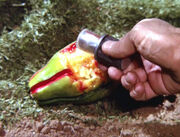
Medscanner used by Dr. McCoy to scan the poison fruit that killed Adam on the planet 'Eden'.
The hand-held medical scanner, colloquially named Medscanner (sometimes nicknamed 'Salt-Shaker' due to its shape), is a small sensor/probe designed to function separately from the tricorder and diagnose by means of auditory emissions. It was a compact hand-held sensor probe used for determining a patient's medical condition while on the field or out of sickbay.
Overview[]
The scanner consists of two parts: a cylindrical rotating scanner head enclosed in a clear casing, and the main body, which held the unit's computer, encased in a rubberized grip, which interprets signals received and converts them to a fluctuating audio readout. At the base of the scanner’s clear casing, where it meets the main body, is a small dial. By twisting it to the desired position, the scanner functioned much like the diagnostic scanner in sickbay – by sensing the physical emanations on an individual at close range. Standard Medscanner units were programmable for ten different functions - pulse rate, respiration, body temperature, cell rate, lung capacity, heart activity, blood pressure, basal metabolic rate, brain activity and homeostatic deviation.
The scanner picks up bodily emanations in the Alpha, Beta, Gamma, Kirlian, Theta, and XI ranges. (ST reference: Star Fleet Technical Manual)
Because the standard medscanner scanner lacks a visual diagnostics display, a physician or other user must undergo extensive training before he is able to interpret the information from the sounds emitted by the scanner, and there is no simple method allowing the layman to do the same. (ST reference: Star Fleet Technical Manual)
Its scanning range appears to be 5 meters (15 feet). Though at times used as a stand-alone device, it was often paired with a tricorder, for close-range focused scans. (Last Unicorn RPG module: Star Trek: The Original Series Core Game Book)
Usage[]
In the year 2268, Commander Spock, first officer and chief science officer of the Federation Starfleet starship USS Enterprise, used a medscanner when the science station picked up an energy reading from the bridge: the source being Elaan's necklace of Radan crystals, 'common stones' on Elas, which were actually dilithium. He was standing at his console and she was near the turbolift alcove. He was able to detect the dilithium from that distance. (TOS episode: "Elaan of Troyius")
Similarly, when Doctor Leonard McCoy scanned the burns Ensign Pavel Chekov received after handling an acid-filled flower on the planet of Eden, he also scanned the bush, then the ground from at least 9 feet, proving that the medscanner had a range of at least 3 to 5 meters. He also used it, at close range, to scan the poisonous pear-like fruit that killed the minstrel Adam. (TOS episode: "The Way to Eden")
Although hand-held medscanners were eventually phased out of use in the 24th century, some doctors or other medical / science personnel still utilize them.[citation needed]
